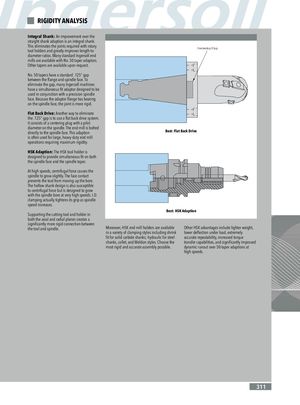Общий каталог Ingersoll 2011 - страница 309
Навигация
- 0003 Table of Contents
- 0006 End Mills
- 0064 Long Edge
- 0104 0Deg Face Mills
- 0160 Face Mills
- 0202 Slotters
- 0218 Form Mills
- 0236 Profile Mills
- 0302 Milling Tech
- 0384 Solid Carbide
- 0448 Solid Carbide Tech
- 0474 Holemaking & Thread Milling
- 0666 Holemaking & Thread Milling Tech
- 0720 Innofit Top On Toolholders
- 0738 HSK Toolholders
- 0774 CAT Toolholders
- 0796 BT Toolholders
- 0816 Adaptions Accessories
- 0872 Turning Inserts
- 1024 Turning Holders
- 1144 Turning Tech
- 1174 Threading Inserts
- 1242 Threading Holders
- 1256 Threading Tech
- 1268 T-Clamp
- 1344 T-Clamp Tech
- 1376 T-CAP
- 1388 T-CAP Tech
- 1394 Product_Index

RIGIDITY ANALYSIS Integral Shank: An improvement over the straight shank adaption is an integral shank. This eliminates the joints required with rotary Centering Plug tool holders and greatly improves length-to- diameter ratios. Many standard Ingersoll end mills are available with No. 50 taper adaptors. Other tapers are available upon request. No. 50 tapers have a standard .125” gap between the flange and spindle face. To eliminate the gap, many Ingersoll machines have a simultaneous fit adaptor designed to be used in conjunction with a precision spindle face. Because the adaptor flange has bearing on the spindle face, the joint is more rigid. Flat Back Drive: Another way to eliminate the .125” gap is to use a flat back drive system. It consists of a centering plug with a pilot diameter on the spindle. The end mill is bolted directly to the spindle face. This adaption Best: Flat Back Drive is often used for large, heavy-duty end mill operations requiring maximum rigidity. HSK Adaption: The HSK tool holder is designed to provide simultaneous fit on both the spindle face and the spindle taper. At high speeds, centrifugal force causes the spindle to grow slightly. The face contact prevents the tool from moving up the bore. The hollow shank design is also susceptible to centrifugal force but is designed to grow with the spindle bore at very high speeds. I.D. clamping actually tightens its grip as spindle speed increases. Best: HSK Adaption Supporting the cutting tool and holder in both the axial and radial planes creates a significantly more rigid connection between the tool and spindle. Moreover, HSK end mill holders are available Other HSK advantages include lighter weight, in a variety of clamping styles including shrink lower deflection under load, extremely fit for solid carbide shanks; hydraulic for steel accurate repeatability, increased torque shanks, collet, and Weldon styles. Choose the transfer capabilities, and significantly improved most rigid and accurate assembly possible. dynamic runout over 50-taper adaptions at high speeds. 311
 Общий каталог Ingersoll 2016 - 2017
Общий каталог Ingersoll 2016 - 2017 Общий каталог Ingersoll 2014
Общий каталог Ingersoll 2014 Каталог Ingersoll инструмент для нарезания резьбы
Каталог Ingersoll инструмент для нарезания резьбы Общий каталог Ingersoll 2013 - 2014
Общий каталог Ingersoll 2013 - 2014 Каталог Ingersoll новинки 2021
Каталог Ingersoll новинки 2021